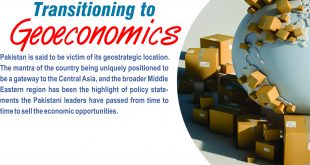Tackling the Menace of Unemployment
If economic growth rate does not produce enough jobs, review the policies!
Hassaan Bin Zubair
It is a hard fact that unemployment has become the number one problem of Pakistan. Irrespective of how you approach the unique set of challenges that face Pakistan, it seems that lack of employment is at the heart of them all. Be it terrorism, health issues or political turmoil, the buck stops at the prevalent job crisis. At present, Four million young people between the ages of 15-24 years are unemployed and this number is set to rise to 8.6 million by 2020. It might be unfair to say that governments have done nothing to address the issue. What is true, though, is that the approach they have used so often is marred by various flaws and needs a major overhaul. The unemployment rate is on the rise, depriving a sizable segment of the population of its livelihood and preventing the harnessing of the real potential of both manpower and natural resources for development.
Pakistan is currently plagued with the menace of unemployment. Pakistan Bureau of Statistics (PBS) in its latest Labour Force Survey (for FY2017-18) claimed that unemployment rate stood at 5.8 percent, down from 5.9 percent in the previous year. The unemployment rate in females decreased to 8.3 percent from 9 percent. However, the unemployment increased in males from 5 percent to 5.1 percent in the new survey. In employment, the own account worker ratio has reduced to 34.8 percent in 2017-18 from 36.1 percent. The contributing family worker ratio stood at 21.4 percent, down from 23.8 percent. Meanwhile, the number of employees has increased to 42.4 percent from 38.7 percent. In sector wise, the employment rate in agriculture sector has gone down to 38.5 percent in 2017-18 from 42.3 percent. On the other hand, employment in industry and services sectors has enhanced during previous fiscal year.
 Economists say that Pakistan needs a growth rate of 7-8 percent on a sustained basis to absorb the increasing number of jobless and clear the backlog. This is not easy. Much depends on the quality of growth that may or may not produce enough jobs. Capital-intensive spending, like high tech, creates jobs for highly skilled people but squeezes the space for the blue-collared jobs. Corporates’ flexible labor policy increasingly denies a life-time career to skilled manpower. Costs are cut by outsourcing ancillary activities or by using contract labour in factories. If a reasonably good economic growth rate does not produce enough jobs, it is time to review economic policies to remedy the situation. Underemployment and joblessness is rampant especially in rural areas leading to migration to ill-planned and over-crowded cities. Often academic qualifications and skills development do not match the changing market demand. Human resource development is a low priority when fresh ideas and the latest technology are shaping new economic activities and trends. Unemployment is turning into a critical issue, also because of increasing global curbs on workers’ immigration. And a job-centered development strategy appears nowhere in sight. For the common citizen job alone is not the only problem. A higher economic growth fuels inflation and raises the cost of living. Most people can’t make a comfortable living if their incomes do not rise commensurately; just to maintain the level of inflation-adjusted real wages from falling. The rising inflation rates are likely to build a case for hiking interest rates and raise cost of commodity production on account of increased financial charges. This would mean more inflation and hence, greater suffering for low-income groups. No doubt in Pakistan the CPEC will help makes the domestic economy somewhat robust and stronger while many businesses will flourish. It will also spur regional cooperation but create more temporary jobs than permanent ones. The common citizen is largely left with no option but to fend for his livelihood. Unable to provide as many jobs as needed, the government takes pride in significantly increasing the amount and the number of poor who receive dole-outs from the national exchequer. Inequality had never been challenged as much an inequity or injustice. If a reasonably good economic growth rate does not produce enough jobs, it is time to review economic policies.
Economists say that Pakistan needs a growth rate of 7-8 percent on a sustained basis to absorb the increasing number of jobless and clear the backlog. This is not easy. Much depends on the quality of growth that may or may not produce enough jobs. Capital-intensive spending, like high tech, creates jobs for highly skilled people but squeezes the space for the blue-collared jobs. Corporates’ flexible labor policy increasingly denies a life-time career to skilled manpower. Costs are cut by outsourcing ancillary activities or by using contract labour in factories. If a reasonably good economic growth rate does not produce enough jobs, it is time to review economic policies to remedy the situation. Underemployment and joblessness is rampant especially in rural areas leading to migration to ill-planned and over-crowded cities. Often academic qualifications and skills development do not match the changing market demand. Human resource development is a low priority when fresh ideas and the latest technology are shaping new economic activities and trends. Unemployment is turning into a critical issue, also because of increasing global curbs on workers’ immigration. And a job-centered development strategy appears nowhere in sight. For the common citizen job alone is not the only problem. A higher economic growth fuels inflation and raises the cost of living. Most people can’t make a comfortable living if their incomes do not rise commensurately; just to maintain the level of inflation-adjusted real wages from falling. The rising inflation rates are likely to build a case for hiking interest rates and raise cost of commodity production on account of increased financial charges. This would mean more inflation and hence, greater suffering for low-income groups. No doubt in Pakistan the CPEC will help makes the domestic economy somewhat robust and stronger while many businesses will flourish. It will also spur regional cooperation but create more temporary jobs than permanent ones. The common citizen is largely left with no option but to fend for his livelihood. Unable to provide as many jobs as needed, the government takes pride in significantly increasing the amount and the number of poor who receive dole-outs from the national exchequer. Inequality had never been challenged as much an inequity or injustice. If a reasonably good economic growth rate does not produce enough jobs, it is time to review economic policies.
If we analyze the situation through a social lens, international cinema has left a huge impact on the minds of our youth. They are unable to accept ordinary jobs and prefer to sit at home rather than doing a commonplace job thereby burdening their already struggling families. This problem is rather common among the lower middle and lower working class as the upper classes tend to either assimilate their kids in their family businesses or secure good jobs through their contacts or wealth. On the other hand, poverty and inflation are increasing day by day, making it even tougher for the poor household to survive. Hence, the unemployed graduates are eventually forced to settle for ordinary jobs as they have a family to feed. At this point in time, the government and the general public need to understand that the only thing we need to focus on right now is identifying the root causes of Pakistan’s wretched economic situation. It will be tough ask for government to solve one of the major problems of Pakistan “Unemployment” due to huge population but still we have given some solutions to reduce the unemployment in Pakistan and we are hopeful by following these solutions the ratio of unemployment in Pakistan can be reduced.
- The first thing to do to reduce unemployment in Pakistan is the proper planning by the government of Pakistan.
- The education system of Pakistan should be equal and well managed.
- Jobs should be given purely on merits.
- There should be no Minority, Disable, Ministerial and Political quota at all.
- The age of superannuation should be reduced to 55 years.
- Well recognized training and technical institutions are need to be established where skills programs are offered.
- Remove energy crisis and reduce energy prices so that investor comes to Pakistan thus job placement will automatically be created.
- There should be peace across the country so foreigners will not hesitate to invest in Pakistan.
- The agriculture sector should be developed.
- Family planning centers should be opened to control the flow of over population.
How to overcome the situation?
Currently, the world’s economy is taking a complete shift from manufacturing sector to the service sector with hoteling and tourism topping the list. However, unfortunately, Pakistan is far behind as far as hoteling and tourism are concerned, owing to the pathetic security situation of the country. Furthermore, the manufacturing sector is not able to sustain itself on account of immense load shedding and high expenses related to electricity. The drowning businesses are being supported through meagre subsidies as a result of which, the national debts keep on increasing. Public is being burdened with indirect taxation to collect revenues, which are then utilized to subsidies the export industry. This has been done merely to show that the government has been able to increase foreign exchange reserves. It is, in fact, nothing more than a political stunt. Fleecing the general public for making a few rich is what it is. Moreover, it allows the Finance Minister to boast about governments’ “achievements”. If the government is genuinely inclined towards reforming the manufacturing sector, cheap electricity alternatives need to be found so that the economy can be made better without providing subsidies. These subsidies can therefore, be used for the public good. Cheap energy is the solution to the problems being faced by the manufacturing sector currently. Even though our manufacturing sector is reducing in size with every passing day, we can still divert our resources to the service sector. Unfortunately, service sector too however, is suffering in the hands of increasing extremism and political uncertainty in the country.
Education and workplace activities go hand in hand and hence following are the three key education trends, according Forbes that employers and potential employees need to keep an eye on this year to upgrade and update their professional skills. Hybrid skills can be useful in this context. It can be defined as the amalgamation of new-age skills such as data analytics, coding and technology/computer as well as the soft/traditional skills which can include problem-solving skills, communication or collaborative skills. The jobs of the future will rely on a set of hybrid skills from a variety of subjects or areas that will change and transform multiple times over the course of our careers. This means that studying or majoring in just one subject at college or university for four years will not be a rational or sensible thing to do in the near future. The higher education degrees need to be much adaptive and flexible and should offer customizable credential offerings to young university graduates. There will be growth in modular learning and education because of its capability to allow learners to personalize the skill-set and knowledge keeping in mind their personal or professional career goals. Secondly, Omni channel is an idea that was born in the retail world but has many important implications on learning as well as other communication channels across all sectors. In today’s network society, consumers expect things to be at their fingertips and education is no different. Workers expect to themselves to be capable enough to learn on-demand or acquire skills or knowledge at that moment and apply them as soon as they get an opportunity. Moreover, in the near future learners will demand more Omni channel experiences that will help them to learn from in-person as well as online mediums. Online programmes should be planned to keep in mind the fluidity needed by learners through which they will able to put their knowledge and understanding to work while working towards a professional degree. While hiring, managers or employers look for an employee who possesses both hard and soft skills. Hard skills are job-specific skills which are acquired through education, certifications and training programmes whereas soft skills are interpersonal skills which include communication skills, collaborative skills, empathy, critical thinking etc. In near future, the pertinence of hard skills will get shorter as technology progresses more swiftly, and inputs become more automated. Soft skills are the new game changer in the working milieu and would soon be an essential requisite for hiring potential candidates. Hence the education sector is accentuating on the need to incorporate soft skill training in the traditional curricula, in order to make graduates more suitable or apt for the job market.
Expert Opinion
There have been significant changes in the sectoral distribution of employment between 2012-13 and 2017-18. The share of agriculture has fallen from 44 percent to 39 percent, while that of industry has increased from 22 percent to 24 percent and that of the service sector from 34 percent to 37 percent. There is strong evidence of greater share of the informal sectors in employment. The rate of increase in jobs in sectors like wholesale and retail trade, transport, construction and private services has been noticeably faster.
There has also been degree of equalization in wages and a reduction in the skill premium due to the lower rate of absorption of educated workers. The growth rate of real remuneration of professionals between 2012-13 and 2017-18 is estimated at 3 percent as compared to 5 percent in the case of workers in elementary occupations. Clearly, this is a major factor which has reduced income inequality among households in the country in recent years.
The other important relationship is between GDP growth and the rate of job creation. Between 2012-13 and 2017-18 the cumulative growth in the size of the economy has been 26 percent. The corresponding growth in employment is 10 percent. Therefore, for every 1 percent growth in the GDP the increase in employment is close to 0.4 percent. This is a relatively low response of employment to economic growth. However, it does highlight that the labor productivity increase is faster. Over the last decade, the productivity contribution to a 1 percent increase in the GDP was faster at 0.6 percent as compared to employment.
The employment response to growth is important to quantify because it highlights the predicament that the country is in. There has been a visible slowdown in the economy during the current financial year. An optimistic expectation is that the growth rate of the economy will be close to 3.5 percent. This implies that the growth rate in the number of jobs is unlikely to exceed 1.4 percent, equivalent to additional employment of 864,000. However, with an increase in the labor force of 1,518,000 there will be a rise in number unemployed of over 600,000 in 2018-19. Consequently, the unemployment rate could rise to over 9 percent.
Given the need for stabilization of the economy over the next two years, especially in the presence of a Fund Program, there is need to recognize that the PTI government target of creating two million jobs annually will probably remain well beyond reach. Instead it will be a better strategy to take special initiatives for creating and targeting more employment opportunities for the educated, young and female workers.
Dr Hafiz A. Pasha (Professor at BNU and former Federal Minister)
 Jahangir's World Times First Comprehensive Magazine for students/teachers of competitive exams and general readers as well.
Jahangir's World Times First Comprehensive Magazine for students/teachers of competitive exams and general readers as well.




